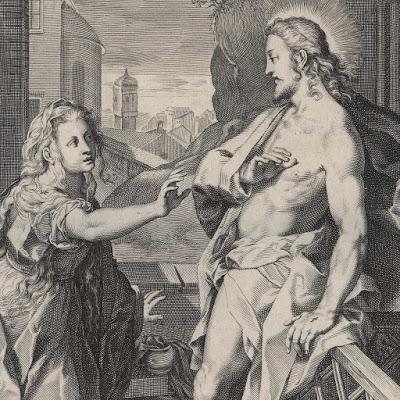Antonius
Wierix II (1555/59–1604)
“Samson destroying the temple of the Philistines” (aka “Simson vernielt
de zuilen van de temple” [Samson destroys the pillars of the temple]), 1585,
from the series, “The History of Samson” (aka “Thesaurus sacrarum historiarum
veteris testamenti, elegantissimis imaginabus expressum excellentissimorum in
hac arte virorum opera: nunc primum in lucem editus”) after Maarten de Vos
(aka Marten de Vos; Maerten de Vos) (1532–1603), published by Gerard de Jode
(aka Geeraert de Jode; Gheerde de Jode; Girard de Jode; Gerardo de Jode;
Gheraerde de Jode) (1516/17–1591) in Antwerp.
Engraving on fine laid paper trimmed close to the plate-mark and backed
with a support sheet.
Size: (sheet) 21.3 x 29 cm.
Lettered in Latin on plate below the image borderline: “Princibibus
Samson ... manu. Judicum.16. Cap. 7”.
State ii (of iii) before the correction of state iii to the first word of
the Latin text from “Princibibus” to “Principibus” and the addition of the
verse numbers (“25.v.”) at lower right.
Mauquoy-Hendrickx 1978 30 (Marie Mauquoy-Hendrickx 1978, “Les Estampes
des Wierix ... catalogue raisonné”, vol. 1., Brussels, Bibliotheque Royale, p. 4,
cat.no. 30, illus. p. 2); Alvin 1866 96; Mielke 18; Hollstein Dutch 40-2(3)
(Wierix Family); Hollstein Dutch 97-2(3) (Maarten de Vos).
The British Museum offers the following description of this print (note
that the BM’s copy is hand coloured):
“To right, a blinded Samson, standing while grasping two pillars of a
temple and pulling it down; some Philistine men and women, seen falling, some
dead under the rubble; an army escaping seen behind, to left.”
See also the description offered by the Rijksmuseum:
Condition: richly inked, superb (near faultless) lifetime impression
showing no sign of wear to the plate, trimmed near to the plate mark and backed
with an archival support of (millennium quality) washi paper. The sheet is in
excellent condition (i.e. there are no tears, holes, folds, abrasions, stains
or foxing).
I am selling this exceptionally rare engraving in museum quality
condition for the total cost of AU$364 (currently US$254.15/EUR226.25/GBP203.01
at the time of this listing) including postage and handling to anywhere in the
world (but not, of course, any import duties/taxes imposed by some countries).
If you are interested in purchasing this stunning masterpiece of early
engraving, please contact me (oz_jim@printsandprinciples.com) and I will send
you a PayPal invoice to make the payment easy.
This print has been sold


















































